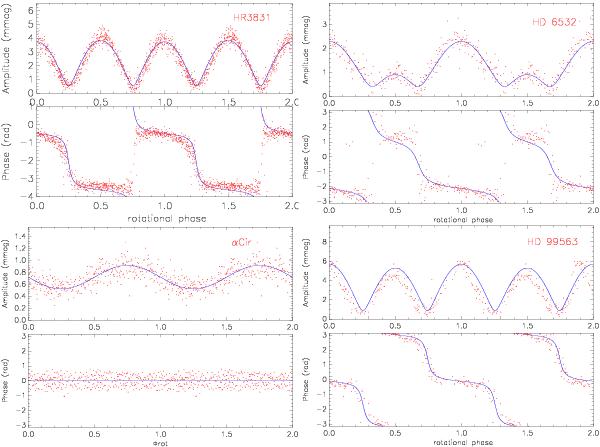Fig. 4

Applications to four roAp stars: HR 3831 (upper left), HD 6532 (upper right), α Cir (lower left), and HD 99563 (lower right). The dots represent the observed values and the full lines the theory. Observational data are from Kurtz et al. (1997a) for HR 3831, Kurtz et al. (1996a) for HD 6532, Bruntt et al. (2009) for α Cir, and Handler et al. (2006) for HD 99563. In our linear treatment of pulsation, the absolute amplitude of the mode is arbitrary. Therefore, the amplitudes of the light curves are scaled so that the observed ones equal the theoretical ones at Φ = 0. The theoretical pulsation phase is with respect to an arbitrary zero-point in time, so is shifted to reproduce the observed pulsation phase at rotation phase Φ = 0. The best-fits to these curves are (i = 68°, γ = 91°, ψ = −7°) for HR 3831, (i = 40°, γ = 70°, ψ = −15°) for HD 6532 (i = 37°, γ = 20°, ψ = 0.5°) for α Cir, and (i = 44°, γ = 86°, ψ = −9°) for HD 99563. The different shapes of the amplitudes are caused by different inclinations of the mode axes with respect to the line-of-sight of the observer. The four modes are almost linearly polarized. The rotational variabilities of the magnetic fields of HD 6532, α Cir, and HD 99563 are not known; such observations will thus test our model for agreement with the angles we have given.
Current usage metrics show cumulative count of Article Views (full-text article views including HTML views, PDF and ePub downloads, according to the available data) and Abstracts Views on Vision4Press platform.
Data correspond to usage on the plateform after 2015. The current usage metrics is available 48-96 hours after online publication and is updated daily on week days.
Initial download of the metrics may take a while.






